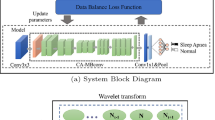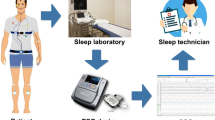Abstract
In this article we present an application of data mining to the medical domain sleep research, an approach for automatic sleep stage scoring and apnea-hypopnea detection. By several combined techniques (Fourier and wavelet transform, derivative dynamic time warping, and waveform recognition), our approach extracts meaningful features (frequencies and special patterns like k-complexes and sleep spindles) from physiological recordings containing EEG, ECG, EOG and EMG data. Based on these pieces of information, an ensemble of decision trees is constructed using the principle of bagging, which classifies sleep epochs in their sleep stages according to the rules by Rechtschaffen and Kales and annotates occurrences of apnea-hypopnea (total or partial cessation of respiration). After that, casebased reasoning is applied in order to improve quality. We tested and evaluated our approach on several large public databases from PhysioBank, which showed an overall accuracy of 95.2% for sleep stage scoring and 94.5% for classifying minutes as apneic or non-apneic.
Similar content being viewed by others
References
Boyle L N, Tippin J, Paul A, Rizzo M. Driver performance in the moments surrounding a microsleep. Transportation Research, 2008, 11(2): 126–136
Rechtschaffen A, Kales A. A Manual of Standardized Terminology, Techniques and Scoring System for Sleep Stages of Human Subjects. Public Health Service, US Government Printing Office, 1968
Keogh E, Pazzani M. Derivative dynamic time warping. In: Proceedings of the 1st SIAM International Conference on Data Mining. 2001
Hanaoka M, Kobayashi M, Yamazaki H. Automatic sleep stage scoring based on waveform recognition method and decision-tree learning. Systems and Computers in Japan, 2002, 33(11): 1–13
Goldberger A, Amaral L, Glass L, Hausdorff J, Ivanov P, Mark R, Mietus J, Moody G, Peng C K, Stanley H. PhysioBank, PhysioToolkit, and PhysioNet: components of a new research resource for complex physiologic signals. Circulation, 2000, 101(23): e215–e220
Borbely A. Secrets of Sleep. New York: Basic Books, 1986
Young T, Palta M, Dempsey J, Skatrud J, Weber S, Badr S. The occurrence of sleep-disordered breathing among middle-aged adults. The New England Journal of Medicine, 1993, 328(17): 1230–1235
Penzel T, Moody G, Mark R, Goldberger A, Peter J. The apnea-ECG database. In: Proceedings of Computers in Cardiology. 2000, 255–258
American Academy of Sleep Medicine Task Force. Sleep-related breathing disorders in adults: recommendations for syndrome definition and measurement techniques in clinical research. Sleep, 1999, 22(5): 667–689
Smith J R, Karacan I. EEG sleep stage scoring by an automatic hybrid system. Electroencephalography and Clinical Neurophysiology, 1971, 31(3): 231–237
Anderer P, Gruber G, Parapatics S, Woertz M, Miazhynskaia T, Klosch G, Saletu B, Zeitlhofer J, Barbanoj MJ, Danker-Hopfe H, Himanen SL, Kemp B, Penzel T, Grozinger M, Kunz D, Rappelsberger P, Schlogl A, Dorffner G. An e-health solution for automatic sleep classification according to Rechtschaffen and Kales: validation study of the somnolyzer 24 × 7 utilizing the siesta database. Neuropsychobiology, 2005, 51(3): 115–133
Park H, Oh J, Jeong D, Park K. Automated sleep stage scoring using hybrid rule-and case-based reasoning. Computers and Biomedical Research, 2000, 33(5): 330–349
Louis R, Lee J, Stephenson R. Design and validation of a computerbased sleep-scoring algorithm. Journal of Neuroscience Methods, 2004, 133(1–2): 71–80
Flexer A, Gruber G, Dorffner G. A reliable probabilistic sleep stager based on a single EEG signal. Artificial Intelligence in Medicine, 2005, 33(3): 199–207
Schlüter T, Kißels T, Conrad S. AS3: a framework for automatic sleep stage scoring. In: Proceedings of 2010 IADIS European Conference Data Mining. 2010
Penzel T, McNames J, de Chazal P, Raymond B, Murray A, Moody G. Systematic comparison of different algorithms for apnea detection based on electrocardiogram recordings. Medical and Biological Engineering and Computing, 2002, 40(4): 402–407
McNames J N, Fraser A. Obstructive sleep apnea classification based on spectrogram patterns in the electrocardiogram. In: Proceedings of Computers in Cardiology 2000. 2000, 749–752
Raymond B, Cayton R M, Bates R A, Chappell M. Screening for obstructive sleep apnea based on the electrocardiogram. In: Proceedings of Computers in Cardiology 2000. 2000, 267–270
de Chazal P, Heneghan C, Sheridan E, Reilly R, Nolan P O’Malley M. Automatic classification of sleep apnea epochs using the electrocardiogram. In: Proceedings of Computers in Cardiology. 2000, 745–748
Mietus J E, Peng C K, Ivanov P C, Goldberger A L. Detection of obstructive sleep apnea from cardiac interbeat interval time series. In: Proceedings of Computers in Cardiology. 2000, 753–756
Zywietz C W, von Einem V, Widiger B, Joseph G. ECG analysis for sleep apnea detection. Methods of Information in Medicine, 2004, 43(1): 56–59
Khandoker A H, Gubbi J, Palaniswami M. Automated scoring of obstructive sleep apnea and hypopnea events using short-term electrocardiogram recordings. IEEE Transactions on Information Technology in Biomedicine, 2009, 13(6): 1057–1067
Mendez MO, Corthout J, Van Huffel S, Matteucci M, Penzel T, Cerutti S, Bianchi A M. Automatic screening of obstructive sleep apnea from the ECG based on empirical mode decomposition and wavelet analysis. Physiological Measurement, 2010, 31(3): 273–289
Chong S K, Gaber M M, Krishnaswamy S, Loke S W. Energy conservation in wireless sensor networks: a rule-based approach. Knowledge and Information Systems, 2011, 28(3): 579–614
Eckert M, Bry F. Rule-based composite event queries: the language XChangeEQ and its semantics. Knowledge and Information Systems, 2010, 25(3): 551–573
Task Force European Society of Cardiology / North American Society of Pacing Electrophysiology. Heart rate variability: Standards of measurement, physiological interpretation and clinical use. Circulation, 1996, 93(5): 1043–1065
Woertz M, Gruber G, Parapatics S, Anderer P, Miazhynskaia T, Rosipal R, Saletu B, Dorffner G. Automatic sleep apnea detection: analysis of apnea distribution with respect to sleep stages depending on the severity of sleep apnea. In: Proceedings of WASM. 2005
Malmivuo J, Plonsey R. Bioelectromagnetism: Principles and Applications of Bioelectric and Biomagnetic Fields. New York: Oxford University Press, 1995
Boggess A, Narcowich F J, Donoho D L, Donoho P L. A first course in wavelets with Fourier analysis. Physics Today, 2002, 55(5): 63–64
Lyons R G. Understanding Digital Signal Processing. Upper Saddle River: Prentice Hall, 2004
Sakoe H, Chiba S. Dynamic programming algorithm optimization for spoken word recognition. IEEE Transactions on Acoustics, Speech, and Signal Processing, 1978, 26(1): 43–49
Rath T, Manmatha R. Word image matching using dynamic time warping. In: Proceedings of 2003 IEEE Computer Society Conference on Computer Vision and Pattern Recognition. 2003, 521–527
Sakoe H, Chiba S. Dynamic programming algorithm optimization for spoken word recognition. In: Waibel A, Lee K F, eds. Readings In Speech Recognition. San Francisco: Morgan Kaufmann Publishers Inc, 1990
Fujimori B, Yokota T, Ishibashi Y, Takei T. Analysis of the electroencephalogram of children by histogram method. Electroencephalography and Clinical Neurophysiology, 1958, 10(2): 241–252
Grossi V, Turini F. Stream mining: a novel architecture for ensemblebased classification. Knowledge and Information Systems (in Press)
Zhou Z H, Li M. Semi-supervised learning by disagreement. Knowledge and Information Systems, 2010, 24(3): 415–439
Katakis I, Tsoumakas G, Vlahavas I P. Tracking recurring contexts using ensemble classifiers: an application to email filtering. Knowledge and Information Systems, 2010, 22(3): 371–391
Mitchell T. Machine Learning. New York: McGraw-Hill, 1997
Breiman L. Bagging predictors. Machine Learning, 1996, 24(2): 123–140
Freund Y, Schapire R E. A decisiontheoretic generalization of on-line learning and an application to boosting. Journal of Computer and System Sciences, 1997, 55(1): 119–139
Breiman L. Random forests. Machine Learning, 2001, 45(1): 5–32
Ho T K. The random subspace method for constructing decision forests. IEEE Transactions on Pattern Analysis and Machine Intelligence, 1998, 20(8): 832–844
Dietterich T G. An experimental comparison of three methods for constructing ensembles of decision trees: bagging, boosting, and randomization. Machine Learning, 2000, 40(2): 139–157
Quinlan J R. Bagging, boosting, and c4.5. In: Proceedings of the 13th National Conference on Artificial Intelligence and the 8th Innovative Applications of Artificial Intelligence Conference. 1996, 725–730
Sun S. Ensemble learning methods for classifying EEG signals. In: Proceedings of the 7th International Workshop on Multiple Classifier Systems. 2007, 113–120
Rzepakowski P, Jaroszewicz S. Decision trees for uplift modeling with single and multiple treatments. Knowledge and Information Systems (in Press)
Moody G, Mark R, Bump M A, Weinstein J S, Berman A D, Mietus J, Goldberger A. Clinical validation of the ECG derived respiration (EDR) technique. In: Proceedings of Computers in Cardiology. 1986, 507–510
Ahlberg J, Nilson E, Walsh J. The Theory of Splines and Their Applications. New York: Academic Press, 1967
Ichimaru Y, Moody G. Development of the polysomnographic database on CD-ROM. Psychiatry and Clinical Neurosciences, 1999, 53(2): 175–177
Author information
Authors and Affiliations
Corresponding author
Additional information
Tim Schlüter is a research associate at the Heinrich Heine University in Düsseldorf, Germany. Currently he is nearing the completion of his doctoral thesis for his PhD in Computer Science. Previously, he studied mathematics specializing in theoretical computer science at the Heinrich Heine University, where he also received his diploma. His research interests are knowledge discovery in databases, and especially temporal data mining and time series analysis. Tim Schlüter is member of ACM and the IEEE Computer Society.
Stefan Conrad is a professor of databases and information systems at Heinrich Heine University in Düsseldorf, Germany. He studied computer science at the Technical University of Braunschweig where he also received his PhD. After that, he was first assistant professor at the University of Magdeburg and then associate professor at Ludwig-Maximilians-University Munich. In 2002 he moved to Düsseldorf. His major research topics are the integration of heterogeneous databases and information systems, multimedia databases, and knowledge discovery in databases. Prof. Conrad is a member of several national and international organizations including ACM, IEEE Computer Society, and GI-German Society for Computer Science.
Rights and permissions
About this article
Cite this article
Schlüter, T., Conrad, S. An approach for automatic sleep stage scoring and apnea-hypopnea detection. Front. Comput. Sci. 6, 230–241 (2012). https://doi.org/10.1007/s11704-012-2872-6
Received:
Accepted:
Published:
Issue Date:
DOI: https://doi.org/10.1007/s11704-012-2872-6




